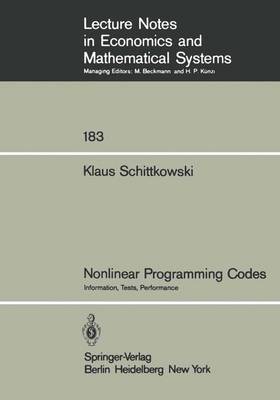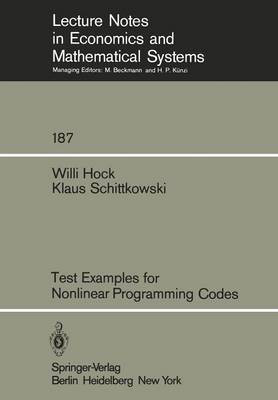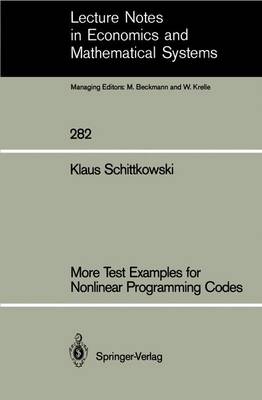Lecture Notes in Economics and Mathematical Systems
3 primary works
Book 183
...The increasing importance of mathematical programming for the solution of complex nonlinear systems arising in practical situations requires the development of qualified optimization software. In recent years, a lot of effort has been made to implement efficient and reliable optimization programs and we can observe a wide distribution of these programs both for research and industrial applications. In spite of their practical importance only a few attempts have been made in the past to come to comparative conclusions and to give a designer the possibility to decide which optimization program could solve his individual problems in the most desirable way. Box [BO 1966J, Huang, Levy [HL 1970J, Himmelblau [HI 1971J, Dumi- tru [DU 1974], and More, Garbow, Hillstrom [MG 1978] for example compared algorithms for unres~ricied u~~illii~Gtiv~ y~~~le~~, B~~n [BD 1970], McKeown [MK 1975], and Ramsin, Wedin [RW 1977l studied codes for nonlinear least squares problems. Codes for the linear case are compared by Bartels [BA 1975.J and Schittkowski, Stoer [SS 1979J.
Extensive tests for geometric programming algorithms are found in Dembo [DE 1976bJ, Rijckaert [RI 1977], and Rijckaert, Martens [RM 1978J.
Extensive tests for geometric programming algorithms are found in Dembo [DE 1976bJ, Rijckaert [RI 1977], and Rijckaert, Martens [RM 1978J.
Book 187
Test Examples for Nonlinear Programming Codes
by W. Hock and Klaus Schittkowski
Published 1 March 1981
................................................................. The performance of a nonlinear programming algorithm can only be ascertained by numerical experiments requiring the collection and implementation of test examples in dependence upon the desired performance criterium. This book should be considered as an assis tance for a test designer since it presents an extensive collec tion of nonlinear programming problems which have been used in the past to test or compare optimization programs. He will be in formed about the optimal solution, about the structure of the problem in the neighbourhood of the solution, and, in addition, about the usage of the corresp,onding FORTRAN subroutines if he is interested in obtaining them -ofi a magnetic tape. Chapter I shows how the test examples are documented. In par ticular, the evaluation of computable information about the solu tion of a problem is outlined. It is explained how the optimal solution, the optimal Lagrange-multipliers, and the condition number of the projected Hessian of the Lagrangian are obtained. Furthermore, a classification number is defined allowing a formal description of a test problem, and the documentation scheme is described which is used in Chapter IV to present the problems.
Book 282
This collection of 188 nonlinear programming test examples is a supplement of the test problem collection published by Hock and Schittkowski [2]. As in the former case, the intention is to present an extensive set of nonlinear programming problems that were used by other authors in the past to develop, test or compare optimization algorithms. There is no distinction between an "easy" or "difficult" test problem, since any related classification must depend on the underlying algorithm and test design. For instance, a nonlinear least squares problem may be solved easily by a special purpose code within a few iterations, but the same problem can be unsolvable for a general nonlinear programming code due to ill-conditioning. Thus one should consider both collections as a possible offer to choose some suitable problems for a specific test frame. One difference between the new collection and the former one pub lished by Hock and Schittkowski [2], is the attempt to present some more realistic or "real world" problems. Moreover a couple of non linear least squares test problems were collected which can be used e. g. to test data fitting algorithms. The presentation of the test problems is somewhat simplified and numerical solutions are computed only by one nonlinear programming code, the sequential quadratic programming algorithm NLPQL of Schittkowski [3]. But both test problem collections are implemeted in the same way in form of special FORTRAN subroutines, so that the same test programs can be used.


